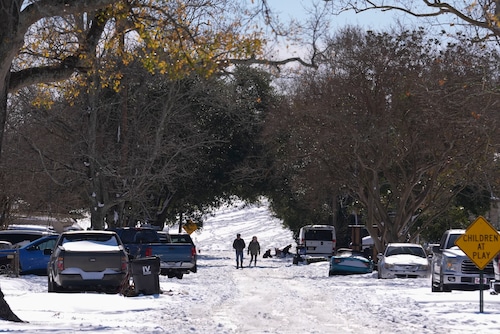By Russ Bynum and Jack Brook, Associated Press
NEW ORLEANS Cleanup efforts were starting Thursday in several major Southern cities, including New Orleans, where workers were clearing snow in the same manner that they remove trash, drink cups, and plastic beads after Mardi Gras, days after a winter storm delivered record-breaking snow and ice.
In the U.S. South, temperatures were steadily increasing, raising expectations that the last of the snow and ice would melt.
Speaking on behalf of the Louisiana Department of Transportation and Development, Daniel Gitlin remarked, “We have to be honest with ourselves: we’re from Louisiana, we know football and crawfish, but we don’t really know snow and ice, and that’s okay.” It will pass, therefore we should allow Mother Nature take care of herself for the time being.
Gitlin stated that dangerous areas of black ice were predicted to keep up to 200 miles (320 kilometers) of interstate closed until Friday. He noted that after treating roads, Louisiana’s supply of salt has almost run out.
A private waste management company has been hired to clear snow from the streets of the Big Easy using equipment that is normally used to clean up Mardi Gras cups and beads.
In order to soften the ice for removal in the historic and joyous French Quarter, IV Waste President Sidney Torres said his company has sent out a 4,000-gallon (15,000-liter) flusher truck to spray water on the ground. According to Torres, the truck typically uses a lemon-scented fragrance to eliminate the nasty odor of pee, alcohol, and vomit from the previous evening. We’re addressing this by coming up with fresh ideas and improved methods.
According to Louisiana Governor Jeff Landry, Arkansas supplied snowploughs, dump trucks, salt spreaders, and other equipment to Louisiana.
The day following an unusual and record-breaking snowstorm in River Ridge, Louisiana, a suburb of New Orleans, on Wednesday, January 22, 2025, snowplows remove snow from Jefferson Highway. (Photo by Gerald Herbert for AP)
The snowfall probably broke a number of records around the area, including in Florida, where, if verified, a preliminary report of 10 inches (25 centimeters) in one town would create a new state record.
This week, Savannah, Georgia, received 3 inches (8 centimeters) of snow, the most since December 1989 in the state’s oldest city.
Metro Atlanta experienced a lighter snowfall, with more snow and ice falling in the southern suburbs than in the northern ones. Jesse Gentes used a flame thrower to clear the ice from his subdivision’s roads in Covington, southeast of Atlanta. He told WSB-TV that when the weather is better, he usually utilizes the flame thrower to remove undergrowth.
At the Edge at Hudson Yards, Thursday, January 23, 2025, in New York, a boat is observed moving while ice floats on the Hudson River. (Photo courtesy of Yuki Iwamura)AP
In the port city of Brunswick and the neighboring Glynn County, where local authorities had enforced an overnight curfew due to slippery roadways and low temperatures, light freezing rain was predicted for Thursday. Nearly 4,000 county residents remained without power Thursday afternoon, according to PowerOutage.us, despite officials opening three warming centers where people could escape the freezing temperatures.
At least one person was killed in the storm, according to South Carolina. According to Berkeley County Coroner Darnell Hartwell, a 71-year-old man passed on Thursday morning from a medical issue while shoveling snow. The National Weather Service estimates that 3–4 inches (8–10 cm) of snow fell in the area.
In coastal South Carolina, the roadways were left in a mess by the snow and ice, which had staying power. The James Island Connector, a bridge that connects Charleston to its western suburbs, was closed overnight due to ice that melted and then froze again. Although personnel are working hard, police stated on social media that a reopening is doubtful anytime soon.
Officials in most areas south and east of Columbia, the state capital, asked residents to stay at home for at least another day, while county offices and schools remained closed.
Following a winter storm that dumped snow and ice on Charleston, South Carolina, on Wednesday, January 22, 2025, Dylan Gilbert of the City of Charleston clears snow in front of City Hall. (Photo by Mic Smith/AP)
The situation was similar in North Carolina, where drivers were still at risk due to slick roadways following overnight melting and freezing. The school district in Cumberland County, where Fayetteville is located, announced that pupils would have an asynchronous learning day that would allow them to finish tasks at home. Other schools were also impacted. The two-hour delay was used by a number of other school districts.
Due to worries about the risk of frozen pipes in schools or the amount of ice still on the roads, several school districts in central and southern Alabama stayed closed on Thursday. Sections of Interstate 65 and Interstate 10 were closed due to ice in Baldwin County, which is coastal.
Airports in the South were starting to recover from the weather disruption. The flight tracking website FlightAware.com reports that by midday Thursday, approximately 600 flights that were planned to arrive at or depart from U.S. airports nationwide had been canceled, which is a significant improvement from earlier days when the storm was at its worst.
Bynum reported from Georgia’s Savannah. Associated Press Writers Jeffrey Collins in Columbia, South Carolina; Makiya Seminera in Raleigh, North Carolina; Sara Cline in Key Largo, Florida; Jeff Martin in Kennesaw, Georgia; and Kim Chandler in Montgomery, Alabama, contributed.
Weather reports

